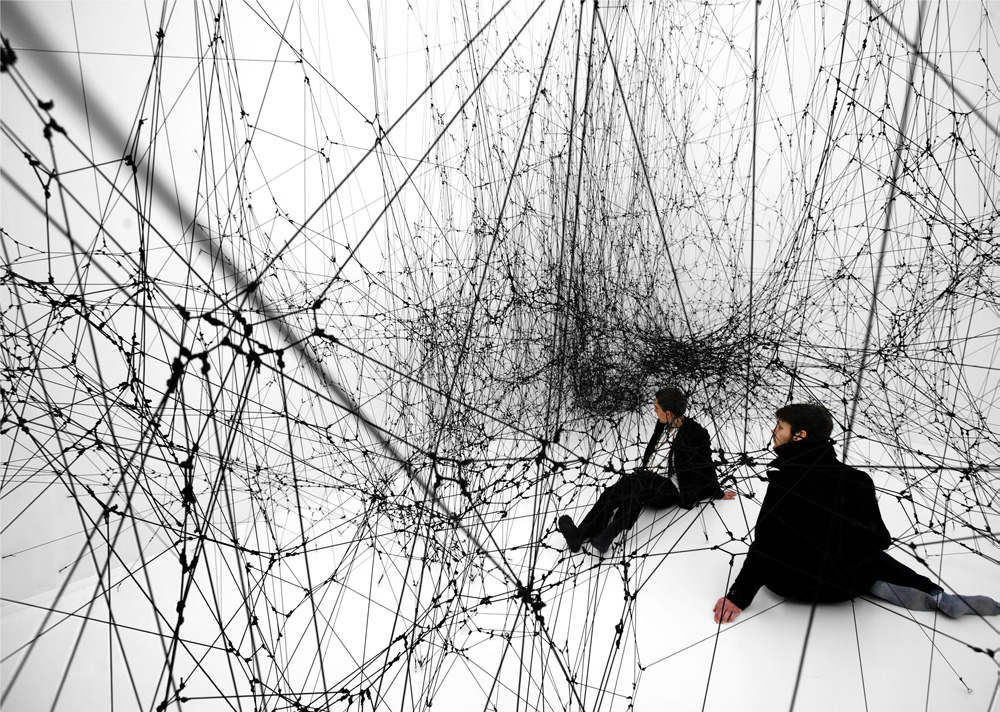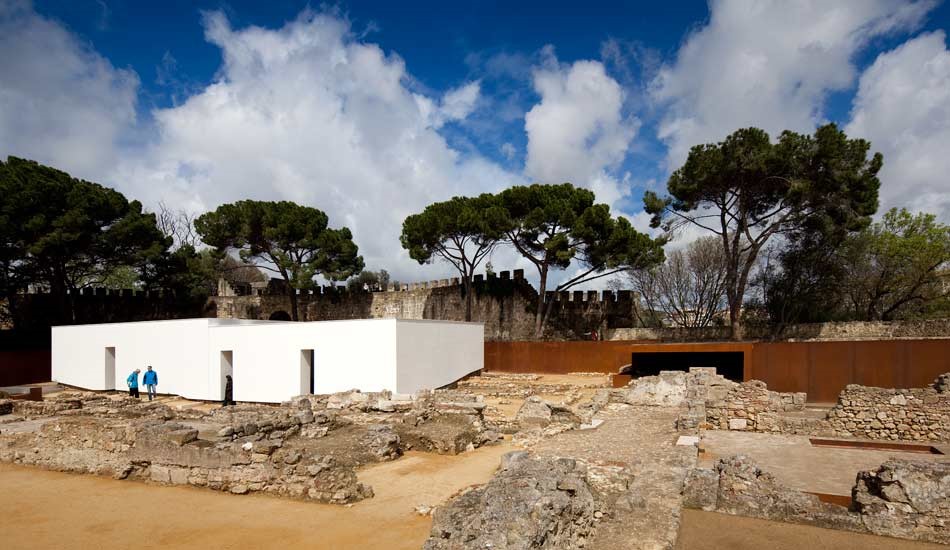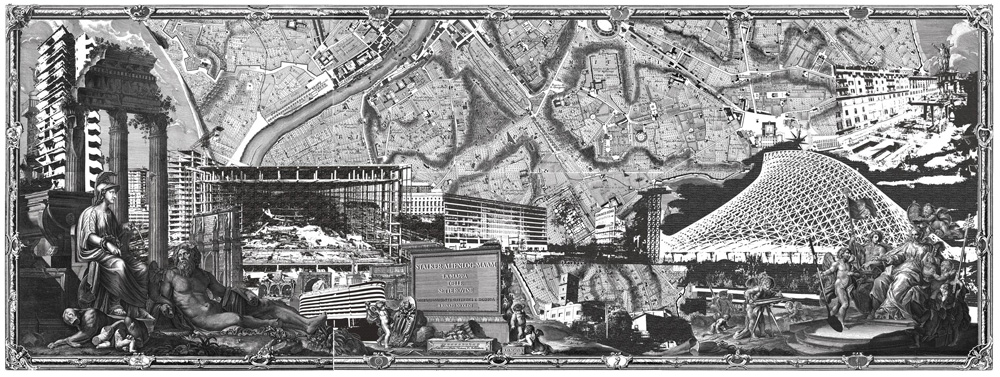Archite(x)ture, Text and pretext of architecture for the ruins.
Chiara Barbieri
Fig.
1 - Billions, Bonniers
Konsthall, Stockholm, T. Saraceno, 2009.

Fig.
2 - Sito archeologico di
Praça Nova Do Castelo De São Jorge, Lisbona, J.
L. Carrilho Da Graça e J. Gomes
da Silva, 2009.

Fig.
3 - La mappa delle sette
rovine, Stalker, Alienlog, MAAM, 2014.

Architecture is a form of language that
aims to transmit messages: in the architectural text, observes Luciano
Semerani, there is an intentional use of forms, a decision-making process that
derives from the desire to achieve certain effects. Also the architectural work
can be understood as a text to be decoded through the analysis of its syntactic
structures and semantic questions, in order to reconstruct the process of
formal choices that lead to a narrative construction[1].
The combination between the narration and the architectural field turned out to
be open and complex, as it is able to constitute a discursive system within
which to meet different opinions and orientations[2].
As Vittorio Gregotti writes, in fact, the story is one of the most concrete
materials for architecture: «la narrazione architettonica (ma non mi pare molto
diverso per gli altri tipi di narrazione) è un procedere-dentro, per mezzo di
un soggetto verso un contenuto che è anzitutto disciplinare, e muove attraverso
di esso e per mezzo di esso, verso qualcosa che può divenire nel significato,
oggi, domani o forse tra molto tempo, per gruppi limitati o per ampie
collettività, senza che ciò possa essere in alcun modo predisposto »[3].
The same idea of writing is nothing but
the metaphor «dell’incessante spostamento e della conseguente, continua
ricollocazione di materiali tematici e motivi formali, soggetti a una costante
evoluzione»[4],
according to Franco Purini.
All architecture is presented as text, but only few cases are examples of
writing: this is composed of signs but the difference between the
linguistic sign and the architectural sign lies in the fact that in
architecture there are no arbitrary signs because they have essentially a
function - formal or structural - and they are always motivated, always
present.
On architecture as a text much has been
written, especially since the eighties of the twentieth century, thanks to the
contribution of the French philosopher Jacques Derrida who has largely dealt
with this issue. In architectural writing he experiments a writing able to
subtract the elaboration of the sense of experience - therefore of thought - to
the sovereignty of logos, understood
as a living word conceived as a unity of
sign and meaning.
The philosopher argues that we need to
start from the spatialization of writing, understood as «irreducible condition
of experience (...) constituted in relation to otherness in general, to the
environment in which it inscribes, which it traverses, modifying it»[5]
and imprinting its own traces for the time to come. If on the one hand, it is
possible to think of architecture as text, in which the different scripts have
stratified over time, in the same way, observes Derrida, it is possible to think of architecture as a writing
subject: «we can understand that architecture itself is writing, which is
not only written [written on] but also writing, actively writing»[6].
In light of this dual nature, he rediscovers
the characteristics of a multidimensional writing capable of retracing the
dynamics of experience as a formulation and of a proper syntax that does not
depend on the sovereign logos[7].
Furthermore, it is possible to inscribe and articulate in architectural writing
the experience in its multidimensionality[8],
since the factual dimension is included in the structure of the architectural
device itself: sequence, open seriality, narrativity, cinematic, dramaturgy,
choreography[9]. Multitemporal value is added to its
multidimensionality: this feature - all within architecture - is even more
evident when working within an architectural text, such as the ruins, which
necessarily involves a reflection on the parts - existing and missing - to
understand the changes over time.
The pre-existing traces in which architectural writing is woven, in fact, «no longer
have the value of documents, annexed illustrations, preparatory or pedagogical
notes» [10]
but contribute to constitute «a voluminous text of multiple scripts» - which is
architecture -, an «over-sedimented textuality, stratigraphy without bottom,
mobile, light and abysmal, stratified»[11].
This is particularly evident in the case
of the project for archeology: this too is the hypothesis of a text that, as
Francesco Rispoli writes, «orders successive 'postils'». As these become mute
even the initial implant of the text and its final coherence is entrusted to
the completion of this 'circular' rewriting
operation[12],
in which past, present and future coincide.
In contemporary culture, there is the idea
that the figure of the architect has the task of acquiring in his own memory
the data collected by the historian and the archaeologist, reading them as a
dynamic process and seeking the values of permanence precisely in the reasons
of the necessary transformations [13]
for the design of the new.
In his American lessons, Italo Calvino
refers precisely to the theme of transformation as the main and vital
characteristic of the literary work: «(…) l’universo si disfa in una nube di
calore, precipita senza scampo in un vortice d’entropia, ma all’interno di
questo processo irreversibile possono darsi zone d’ordine, porzioni d’esistente
che tendono verso una forma, punti privilegiati da cui sembra di scorgere un
disegno, una prospettiva. l’opera letteraria», e tanto più l’opera di
architettura, «è una di queste minime porzioni in cui l’esistente si
cristallizza in una forma, acquista un senso, non fisso, non definitivo, non
irrigidito in una immobilità minerale, ma vivente come un organismo»[14].
Like a literary work, even an architecture
is such when it survives its time and transforms plastically and semantically
to adapt to the needs and qualities of the epochs that happen to it. This
concept is also expressed by Daniel Libeskind in Radix-Matrix, when he writes
that «if I were sure (...) [that a] work will never be altered, then it would
not be a work. A work must be left beyond your life, left exposed to
manipulation or reinterpretation. This is the reason why you build. Fragility
itself is part of the possibility of the work»[15].
The re-interpretation of which Libeskind speaks follows multiple
interpretations that modify both the object of interpretation and the
interpreter approach. This is because a relationship is established, a
mediation that makes the investigated and interpreted past simultaneous with
the present of the interpreter, with the contemporary unknowingly experienced
by the designer[16].
In this way, it is generated what Vittorio
Gregotti calls 'semantic thickening' of a work, due to the narrative
interpretation / modification of a context: the design of the new, therefore,
must be considered in this light, as an interpretation of the relationship of
mutual interdependence between pre-text
(pre-existence, ruin, the past) and con-text
(the landscape, the present and the history of places), beacause one manages to
describe and give meaning to the other, in an always reversible process.
Alongside the interpretative role of the
new project in relation to the pre-existence, however, it is possible to
recognize a parallel and active role of the project: starting from the reading,
interpretation and understanding of the work just come to light, the project
takes on a further meaning, becoming itself a text, because, as Torsello
observes, «il comprendere non è mai solo un atto riproduttivo, ma anche un atto
produttivo (…) secondo un ciclo produttore di senso che si rinnova sempre»[17].
It is by virtue of this operation of rewriting
of architecture that the archaeological ruin can be described as an open
and virtual work.
To work with the ruins, it is therefore
necessary to carefully understand the orientations that they are able to offer,
in order to transform them into sympathetic entities of the contemporary [18]:
the way in which this process is implemented can not be univocal because
univocal is not the meaning of ruin.
Among the possible approaches there is
what Andres Hild calls "continue to
write": this idea does not worry if continuity or recourse to
innovation is necessary, but «is concerned with all its internal reason and not
its linear classification»[19].
The "continue
to write" considers, in fact, architecture as a form of writing with
its own internal rules but open to different interpretations, in which
archeology becomes an active and foundational matter: archaeological ruins
therefore present themselves as shreds of ancient texts, words that need to be
re-circulated, through new languages and new narrative rhythms that have
changed over time.
As Raffaele Panella writes, in fact, if we
do not consider considerano «i resti (…) come materiale del progetto moderno,
per essere più chiari, se essi non sono declinabili nello stesso sistema
semiologico dell’architettura, è come se lavorassimo ad una grande tela con dei
buchi. Abbiamo fatto un passo avanti notevole nel senso della continuità
risolvendo le connessioni, i bordi (su cui in ogni caso c’è ancora tanto da
esplorare), ma se dobbiamo entrare (…) in quello che Manacorda chiama “lo
spazio archeologico”, con l’obiettivo di comunicare attraverso l’uso e la
forma, quale che sia, il senso di quel luogo, non c’è altro modo che
considerare i resti, i pezzi (…), come materiali manipolabili
dall’architettura, in un rapporto che non può essere altro che di
contaminazione. D’altra parte, tutte le grandi opere che testimoniano di una
continuità realmente realizzata sono effetto di una contaminazione»[20].
The great temporal distance between the
past of archeology and contemporary poses the question of the language and the
different interpretations of stratified texts at the center of the
compositional problem. The overlap of the architectural layers manifests itself
in the quality of the relationship - or of the relationships - between the new
and the existing.
A possible choice, rich in unexplored
potential, of designing in the archaeological field is precisely that of
accepting the logic of the project itself as a linguistic act that, starting
from the objects it has, ie the ruins - the same objects that Claude
Lévi-Strauss would call les moyens du
bord[21]
- and from which it turns out to be disposed, it determines new sorting
relationships, new forms that are critically modifying and meaningful, just as
the bricoleur does.
Interacting with the pre-existences, with
the relationships between the parts, with the materials and sometimes with
«simple clues emerging from the interstices of torn plots»[22],
necessarily involves the selection of some available elements, some signs, to
organize them according to criteria and techniques that determine hierarchies
and sequences, through a narrative rhythm.
These relationships redefine connections
with the ruins, revealing the potential and value of the places full of
memories, rather than foreseeing a foregone contrast between old and new.
Through the signs of the ancient, significant traces received as an inheritance,
the designer identifies the permanencies and long lasting elements that determine the project, interpreting
their past.
Considering the project as a narration and
as a linguistic act, necessarily leads to analyze those that are the basic
techniques of this process: the compositional control of new architectural
ensembles comprising pre-existences and made up of different parts, linked by
strong formal, functional and constructive addictions, takes place in this
light on the basis of linguistic, syntactic and typological techniques[23].
Imitation, quotation, autonomy,
hypothesis, parataxis, analogy, hybridization and contrast become the tools
through which the designer can define a possible path that avoids mechanically
finding its definition elements in the pre-existing contextual field and at the
same time avoids referring to abstract models without any memory of the place[24],
continuing to write with the past future tales.
Notes
[1] Marzo M. (2010) - “Postfazione”. In:
M. Marzo (a cura di), L’architettura come
testo e la figura di Colin Rowe. Marsilio Editori, Venezia, 201.
[2] Purini F. (2012) - “Scrivere
Architettura”. In: F. Rispoli (a cura di), Dalla
forma data alla forma trovata. Luciano Editore, Napoli, 57.
[3] Gregotti V. (1987) - “Della
narrazione in architettura”. Casabella, 540, 2-3.
[4] Purini F. (2012) - cit., 58.
[5] Vitale F. (2012) - “Tracciare
Disegnare Pensare. Jacques Derrida e la scrittura architettonica”. In: F.
Rispoli (a cura di), cit., 77.
[6] Cfr. Derrida J., Eisenman P.
(1993) - “A proposito della scrittura. Jacques Derrida e Peter Eisenman”. Any, 0.
[7] Cfr. Rispoli F. (2012) - cit.,
80-81.
[8] Cfr. Tschumi B. (1994) - Manhattan Transcripts. Academy Group,
London.
[9] Cfr. Cuomo A. (2015) - La fine (senza fine) dell’architettura.
Verso un philosophical design. Deleyva Editore, Roma, 64.
[10] Derrida J. (1986) - “Point de folie - maintenant l’architecture”. In: B. Tschumi, La case vide. La villette. Architectural
Association, London.
[12] Rispoli F. (1990) - Forma e Ri-forma. Interpretare/ progettare
l’architettura. CUEN, Napoli, 100.
[13] Cao U. (1995) - Elementi di progettazione architettonica.
Università Laterza Architettura, RomaBari, 3.
[14] Cfr. Calvino I. (1988) - Lezioni americane. Garzanti, Milano.
[15] Cfr. Libeskind D. (1997) - Radix-Matrix. Prestel, Munchen-New York.
[16] «L’essenza dello spirito storico
non consiste nella restituzione del passato, ma nella mediazione, operata dal
pensiero, con la vita presente». Gadamer H. G. (1986) - Verità e
metodo. Bompiani, Milano, 207.
[17] Torsello B.P. (1997) - “Conservare
e comprendere”. In: B. Pedretti (1997) - Il
progetto del passato. Memoria, conservazione, restauro, architettura, cit.
in V. Bagnato (2013) - Nuovi Interventi
sul Patrimonio Archeologico. Un contributo alla definizione di un’etica del
paesaggio, Tesi di Dottorato in Proyectos Arquitectonicos, E.T.S.A. di
Barcellona (Universidad Politécnica de Cataluña).
[18] Cfr. Izzo F. (2014) - “Sostenere
la civiltà. Contemporaneità e topografia del tempo”. In: A. Capuano (a cura di)
(2014) - Paesaggi di rovine. Paesaggi
rovinati, Quodlibet, Macerata, 276.
[19] Intervista riportata anche in Hild
A. (2012) – “Gedacht/ Gebaut. Valutazioni architettoniche”. FAmagazine, 21.
[20] Panella R. (2014) - “Per la
continuità”. In: A. Capuano (a cura di), cit., 66.
[21] Cfr. Derrida J. (1971) - “La struttura,
il segno e il gioco”. In: J. Derrida, La
scrittura e la differenza. Einaudi, Torino.
[22] Rispoli F. (2016) - Forma data forma trovata. Istituto
Italiano per gli Studi Filosofici, Salerno, 131.
[23] Cfr. Cao U. (1995) - cit.
[24] Cfr. Rispoli F. (2016) - cit., 134.
Bibliography
ARNHEIM R. (1981) - La dinamica della forma
architettonica, Feltrinelli, Milano.
CALVINO I. (1988) - Lezioni
americane, Garzanti, Milano.
CAO U. (1995) - Elementi
di progettazione architettonica, Università
Laterza Architettura, Roma-Bari.
CAPUANO A. (2014) - Paesaggi
di rovine. Paesaggi rovinati, Quodlibet, Macerata.
CUOMO A. (2015) - La
fine (senza fine) dell’architettura. Verso un philosophical
design, Deleyva Editore, Roma.
DE FUSCO R. (1978) - Segni,
storia e progetto dell’architettura, Laterza,
Bari.
DERRIDA J. (2008) - Adesso
l’architettura, (a cura di) VITALE F.,
Scheiwiller, Milano.
DERRIDA J. (1971) - La
scrittura e la differenza, Einaudi, Torino.
ECO U. (1968) - La
Struttura Assente, Bompiani, Milano.
ECO U. (1979) - Lector
in Fabula, la cooperazione interpretativa nei testi narrativi,
Bompiani, Milano.
GADAMER H. G. (1986) - Verità
e metodo, Bompiani, Milano.
GENETTE G. (1989) - Soglie.
I dintorni del testo, Einaudi, Torino.
GRASSI G. (2000) - Scritti
scelti 1965-1999, Franco Angeli, Milano.
GREGOTTI V. (1986) - Questioni
di architettura, Einaudi, Torino.
JACOB F. (1978) - Evoluzione
e Bricolage. Gli “espedienti” della selezione
naturale, Einaudi, Torino.
JUNGER E. (2000) - Al
muro del tempo, Adelphi, Milano.
KOENIG G. K. (1964) - Analisi
del linguaggio architettonico, LEF, Firenze.
LÉVI-STRAUSS C. (2010) - Il pensiero selvaggio,
Il Saggiatore, Milano.
LIBESKIND D. (1997) - Radix-Matrix,
Prestel, Munchen-New York.
MARZO M. (2010) - L’architettura
come testo e la figura di Colin Rowe, Marsilio Editori,
Venezia.
PRESTINENZA PUGLISI L. (2016) - Architettura
del racconto: prime riflessioni, presS/T letter,
http://presstletter. com/2016/02/architettura-del-racconto-prime
-riflessioni/
PURINI F. (2000) - Comporre
l’architettura, Laterza Editore, Bari.
RISPOLI F. (2012) - Dalla
forma data alla forma trovata, Luciano Editore, Napoli.
RISPOLI F. (1990) - Forma
e Ri-forma. Interpretare/progettare l’architettura,
CUEN, Napoli.
TSCHUMI B. (1994) - Manhattan
Transcripts, Academy Group, London.
ZUCCHI C. (2014) -
Innesti. Il nuovo come metamorfosi, Marsilio, Venezia.


